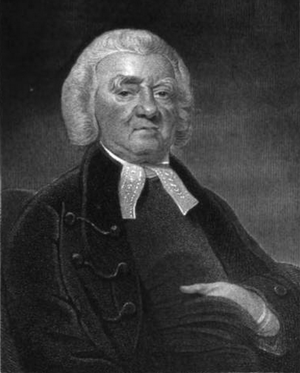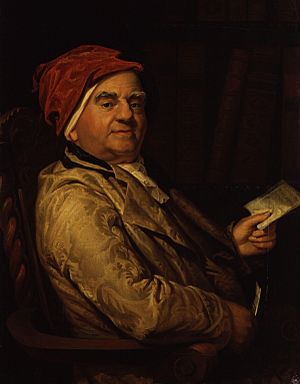Samuel Parr facts for kids
Quick facts for kids
Samuel Parr
|
|
|---|---|
 |
|
| Born | 26 January 1747 Harrow on the Hill, England
|
| Died | 6 March 1825 (aged 78) Hatton, Warwickshire, England
|
| Nationality | British |
| Occupation | Schoolmaster |
| Known for | Schoolmaster, Writer |
Samuel Parr (born January 26, 1747 – died March 6, 1825) was an English schoolmaster, writer, and minister. He also earned a special degree in law. During his life, he was famous for his political writings. Some people even called him "the Whig Johnson," comparing him to the famous writer Samuel Johnson. However, Parr's fame did not last as long. He was not known for his writing style, but he was important in the world of literature. Samuel Parr wrote many letters and stayed in touch with his students. He was very involved in the intellectual and political discussions of his time.
Contents
Samuel Parr's Life Story
Early Years and Education
Samuel Parr was born in Harrow on the Hill, England. His father, also named Samuel Parr, was a surgeon. His mother was Ann. Samuel's father was a determined and educated man. He started teaching his only son Latin grammar when Samuel was just four years old.
In 1752, Samuel began attending Harrow School as a free student. He left the school in 1761. After leaving, he started helping his father with his medical work. His father wanted Samuel to become a doctor. However, Samuel was very stubborn. He kept refusing to learn more about medicine.
In November 1762, Samuel's mother passed away. Less than a year later, his father married again. His new wife was Margaret Coxe. Samuel, who was sixteen at the time, was not happy about this marriage.
Eventually, Samuel was allowed to stop studying medicine. Instead, he could study to become a minister. In 1765, he went to the University of Cambridge. He joined Emmanuel College, Cambridge. He later wrote that his teachers there were "eminently able" and "uniformly kind" to him.
Just a few months into his time at Cambridge, Samuel's father died. This happened in January 1766, when his father was 54. Even with some money from Harrow School, Samuel faced financial problems. He could not continue his studies without going into debt. So, he had to leave Cambridge. Because of the rules, he could still get a degree in divinity later. He would not need to be a student at the university to do so.
Teaching Career and School Leadership
Samuel needed money and wanted to keep learning. So, he decided to go back to Harrow School. From 1767 to 1771, he worked as a head assistant. He worked under Robert Carey Sumner, who was his friend. One of his students at Harrow was Richard Brinsley Sheridan, who became a famous playwright. Samuel earned about £100 a year, which included his salary and fees from private students.
In September 1771, the headmaster died. Samuel immediately applied for the job. However, Harrow School required all applicants to have a Master of Arts degree. Cambridge University quickly gave him an honorary degree. All his former teachers spoke highly of him. But he was not chosen for the headmaster position.
Samuel became a deacon on Christmas Eve 1769. For a short time, he worked in nearby churches in Willesden and Kingsbury. In October 1771, he got a special license from the bishop. He then opened his own school in Stanmore. He married Jane Marsingale the next month. He might have married quickly because he needed a female manager for the school.
Samuel took between 20 and 40 students from Harrow with him. But his school failed after five years. It could not compete with the larger, more established Harrow School. However, during his time there, he made important changes to the school's lessons. He started teaching English and its grammar, not just Latin. He even published a book called Introduction to English Grammar in 1765.
In 1776, Samuel was chosen to be the headmaster of Colchester Royal Grammar School. He moved his family to Colchester in 1777. He fixed the school buildings, which had fallen apart. He also rented a house nearby for students who lived at the school. In 1908, a school house was named after him to honor his work there.
He only stayed at Colchester for about a year. He had arguments with the school's leaders. But he made two lifelong friends there: Thomas Twining and Reverend Dr. Nathaniel Forster. He also became a priest in 1775. This was done by Bishop Lowth, who also supported teaching English in schools. At his friend Dr. Forster's request, he also worked in two churches in Colchester.
On August 1, 1778, Samuel Parr was chosen to be the master of the grammar school in Norwich. He moved to the city early the next year to start his new job. Money was still a worry for Samuel. But he found happiness in Norwich. He was surrounded by a group of dedicated scholars. Soon after, he became a curate for Reverend William Tapps. He served the churches of St. George's Colgate and St. Saviour.
Samuel then focused on getting a doctorate degree. He couldn't get one in divinity, so he switched his studies to law. The University of Cambridge gave him an LL.D. (Doctor of Laws) degree in 1781.
Later Life and Retirement
Towards the end of 1785, Samuel decided to leave Norwich. His job as headmaster did not pay well, and it took up a lot of his time. Also, in 1780, he was given a small church job in Asterby, Lincolnshire. Three years later, he got another church job in Hatton, near Warwick. The first job paid £36 a year, but the Hatton job paid around £100. He gave up the Asterby job to his assistant at Hatton. These new jobs paid him better and gave him more free time. He used this time to tutor students privately, earning more money.
In 1788, there was a chance that the Prince of Wales would become the Regent. This almost made Parr a bishop. William Pitt the Younger was in power because of King George III. But the King's health got worse. Parliament was very close to making the Prince of Wales the Regent. The Prince, known as Prinny, supported Charles James Fox. Fox was a friend of Parr's. It seemed likely that if the Prince became Regent, he would choose Fox to be the Prime Minister. Fox, in turn, would have likely nominated Parr to be the Bishop of Gloucester.
However, the King's health improved, and the Regency Bill never passed. So, Parr did not become a bishop. But the Whigs did give him £300 a year. This money helped him at times during his retirement.
In 1789, he swapped his church job in Hatton for one in Wadenhoe, Northamptonshire. But he made sure he could still live in the parsonage (church house) in Hatton as an assistant. Here, he spent the rest of his life. He enjoyed his excellent library, which was described in a book called Bibliotheca Parriana (1827). His friends Richard Porson and Edmund Henry Barker spent many months with him.
Sadly, in his later years, Parr often caught bad colds. From two of these colds, he developed a skin infection called erysipelas. He recovered from the first one, but not the second. He was sick for a long time but faced it with patience and faith. Samuel Parr died at Hatton parsonage on March 6, 1825.
Samuel Parr's Beliefs and Personality
Even during the scary times of the French Revolution, Parr remained loyal to the Whig political ideas. He wrote letters to many important people in literature and politics who shared his beliefs. He strongly supported Charles James Fox. He also strongly disliked William Pitt the Younger.
In his private life, Samuel Parr tried to be like Samuel Johnson. He copied Johnson's rough and formal way of speaking. However, Parr did not have Johnson's humor or his true authority. Parr was famous for writing epitaphs, which are inscriptions on tombstones. He wrote them for the graves of Edmund Burke, Charles Burney, Johnson, Fox, and Edward Gibbon.
About Parr's religious beliefs, he once said:
My principles, I am sure, will never endanger the church [of England] – my studies, I hope, are such as do not disgrace it – and my actions, I can say with confidence, have ever tended to preserve it from open, and what I conceive to be unjust attacks.
He believed his actions and studies helped protect the Church of England.
Samuel Parr's Writings
Samuel Parr wrote many books and essays. However, many people felt his writings were not as impressive as his reputation. His reputation came from his wide knowledge and strong opinions in conversations.
His main writings include his Characters of Charles James Fox (1809). He also edited and reprinted Tracts of Warburton and a Warburtonian. This caused some arguments. In his review of Warburton, he focused on the worst writings by William Warburton and Hurd. These writings probably did not deserve to be reprinted. Their authors were even trying to keep them from being published again.
His Latin introduction to The Three Treatises of Bellendenus is also important. It was considered a great example of modern Latin writing.
John Johnstone listed about 1500 people Parr wrote letters to. This list included two members of the royal family. It also included four archbishops. There were also many dukes, marquesses, earls, viscounts, lords, knights, judges, and members of parliament. This shows how many important people he knew.
In 1813, Samuel Parr wrote the Latin inscription on King Richard's Well. This well is at the site of the Battle of Bosworth in Shenton.
Books About Samuel Parr
There are two main books written about Samuel Parr's life. One was written by William Field in 1828. The other, which also includes his works and letters, was written by John Johnstone in 1828. Edmund Henry Barker also published two volumes called Parriana in 1828-1829. This book contained a lot of information about Parr and his friends.
An essay about his life, titled Dr. Samuel Parr: or, Whiggism in its relations to literature, is in Thomas de Quincey's works. A small book of his Aphorisms, Opinions and Reflections was published in 1826.


